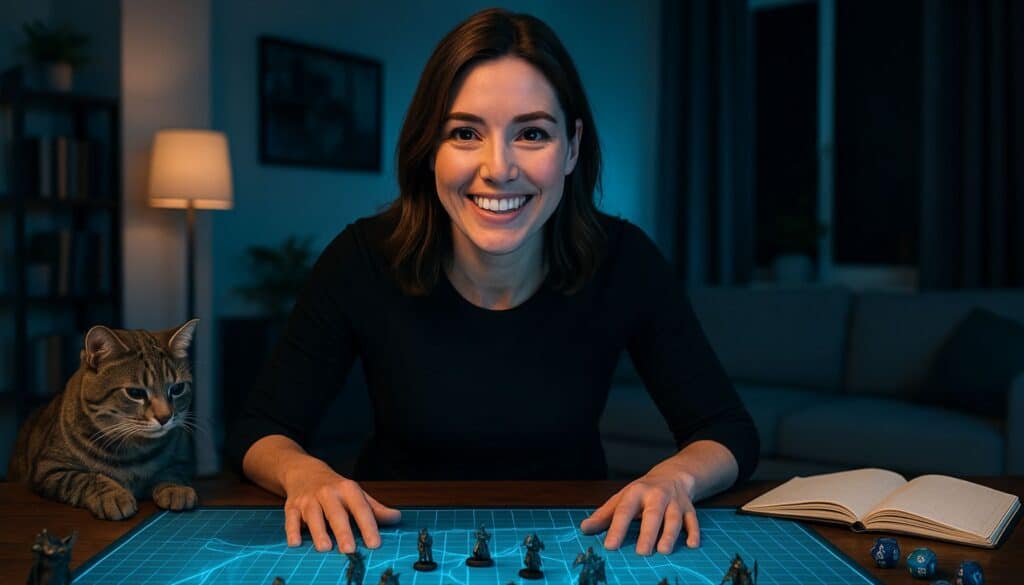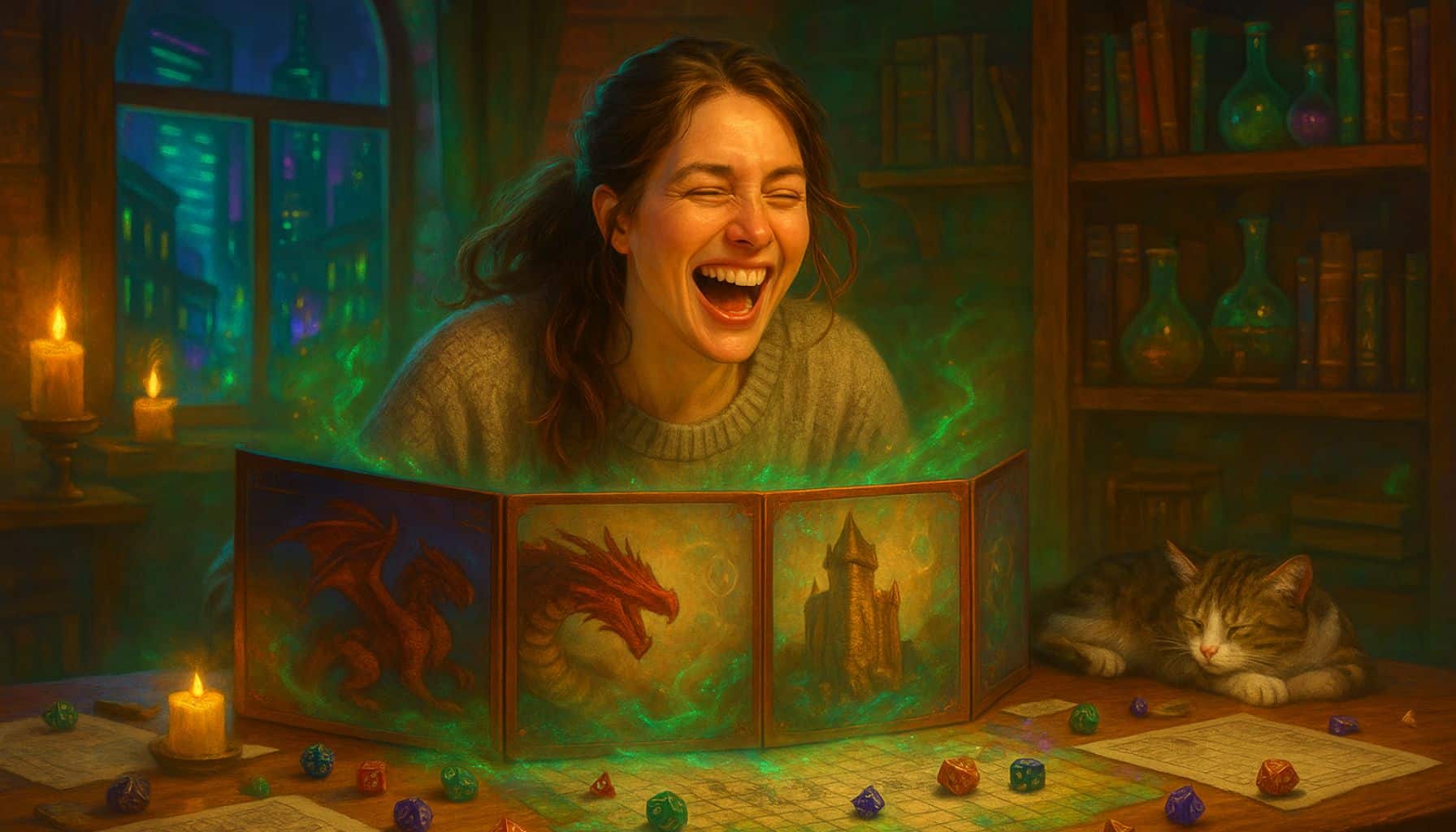Dungeon Mastering in Dungeons & Dragons is as much an art as it is a science. Over countless sessions, most DMs discover they gravitate towards one of two broad styles: the Storyteller and the Tactical DM. These categories aren’t strict boxes meant to confine you, but rather useful mirrors, reflecting your habits, preferences, and creative strengths. Think of them as guideposts guiding your ongoing journey as a game runner, not labels to restrict your approach. This article isn’t about putting you in a corner—it’s about self-discovery and expanding your horizons behind the screen.
Every Dungeon Master has a unique flavor, a signature way of shaping the tabletop experience. Yet, underneath that creative flourish, patterns emerge. Some DMs feel most alive when weaving intricate plots and fleshing out memorable NPCs, while others light up at the prospect of brilliantly balanced battles and puzzles that test their players’ cunning. Most DMs find themselves somewhere between, combining elements from both camps as their games and their groups evolve… some even finding great AI RPG tools for fantasy and more.
This spectrum is a playground, not a battleground. Storytelling DMs and Tactical DMs both create amazing, memorable adventures for their players, simply by focusing on different elements. Your natural style isn’t a weakness to hide, but a strength waiting to be honed. Exploring where you sit along the continuum can unlock new ways to engage your friends and make your game nights even more special.
So, as you read on, let curiosity be your compass. Ask yourself where your passion lies: Do you savor narrative crescendo and emotional drama, or do you delight in the thrill of the well-played strategy? Maybe, like most DMs, you dance between both worlds. By reflecting on your own instincts and experiences, you’ll gain insight not only into your style, but how you can keep growing as a Dungeon Master.
The Storyteller DM
Storyteller DMs are the bards and playwrights of the dungeon. For them, the table is a stage, and the characters—both players and NPCs—are actors in an ever-unfolding epic. Their games are thick with atmosphere, driven by deep character arcs and worldbuilding that begs to be explored. They craft intricate mysteries, chart emotional journeys, and plant the seeds for jaw-dropping plot twists, all in service of forging a campaign that feels like an epic saga.
Improvisation is a watchword for the Storyteller DM. Rules are important, but only as long as they serve the story. If a clutch moment would hit harder by bending or ignoring a rule, the Storyteller won’t hesitate. They encourage players to dream big, rewarding imaginative problem-solving, creative roleplay, and ideas that defy convention. In these games, the narrative takes priority, and the rules are tools, not chains.
Try my AI Tabletop RPG generators...and an extensive library of content!
Sessions led by Storyteller DMs often pulse with moments of heartbreak, triumph, and surprise. The world feels alive, brimming with NPCs who have ambitions and secrets of their own. You’re just as likely to find yourself embroiled in tense negotiations with a shadowy syndicate as you are delving into abandoned crypts in pursuit of lost lore. Immersion is king, and every twist is engineered to draw the table deeper into the fantasy.
Yet, this approach isn’t just about dramatic flair—it’s about fostering connection. Storyteller DMs understand the power of player investment, sometimes letting the emotional resonance of a scene outweigh considerations of balance or challenge. They thrive on eliciting laughter, tears, and gasps of revelation. For these DMs, the most precious treasure is the story you share at the end of the night.
15+ Signs You’re a Storyteller DM
- You draft detailed backstories for every significant NPC—even if the players never meet them.
- You adjust combat encounters on the fly to suit the pace of the narrative.
- Plot twists and secrets are your bread and butter.
- You prioritize player immersion and emotional buy-in over absolute rules adherence.
- Your sessions feature moral dilemmas and choices with real consequences.
- You treat the rules as guidelines, not strict boundaries.
- Descriptions of the environment and characters are lavish, bordering on poetic.
- You often encourage creative solutions, even if they upend your plans.
- Puzzles and mysteries focus on drama and revelation rather than solely logic.
- Player backstories regularly intertwine with the main plot.
- Character-driven scenes sometimes take precedence over combat.
- You initiate “cutscenes” or dream sequences to build mood or foreshadow events.
- You use music, props, or thematic handouts to set the tone.
- NPC motivations are layered and complex.
- Failure often leads to interesting story developments, not just dead ends.
- You allow players to dramatically alter the world through their choices.
- Flashbacks, visions, or prophecies are common narrative devices at your table.
Storyteller DMs bring a sense of wonder and connection to every session. Their strengths lie in making every moment feel meaningful, every encounter rich with possibility. They invite players to invest emotionally, resulting in games that linger long after the final dice have been rolled—creating memories that endure well after the campaign concludes.
That said, this style isn’t without its pitfalls. Players who thrive on rules clarity or tactical challenge may sometimes feel adrift in Storyteller campaigns where consistency bends to narrative logic. Over time, pure storytelling can cause tension if some group members crave more structure or fairness in mechanical gameplay. It’s a delicate balance; the most successful Storyteller DMs learn to weave in enough rules consistency and strategic challenge to keep all players engaged, while never losing sight of their story-driven strengths.

Fantasy RPG AI Generators with ChatGPT+
Make life as a Game Master easier.... If you play Dungeon & Dragons, Pathfinder, or other fantasy tabletop role-playing games, check out my DND character backstory generator and other fine AI RPG tools at LitRPG Adventures Workshop today.

The Tactical DM
Tactical DMs are architects of challenge and structure, masters of the rulebook who delight in crafting experiences where clever thinking and strategy reign supreme. Their tables are maps of the adventure, every grid and monster stat block a piece of a larger, balanced puzzle to be solved. The thrill comes from fair tests of player skill—not just luck or narrative direction.
Rules accuracy is the Tactical DM’s foundation. Fairness is paramount, and the rulebook is a trusted ally. They relish the intricate dance of initiative, relish the architecture of a tightly designed dungeon, and savor the anticipation as players piece together clues, maneuver battle positions, and stretch their resources to the limit. Puzzles and traps become elaborate playgrounds for ingenuity, rewarding preparation and adaptability.
A session run by a Tactical DM feels precise and intentional. Encounters are often finely tuned, balancing challenge and reward so neither the DM nor the players ever have an unfair advantage. There’s a focus on clear stakes—where small missteps can lead to disaster, but clever play is recognized and rewarded. Success tastes sweeter when hard-earned.
Narratives aren’t absent at a Tactical DM’s table, but they serve as context for the real drama: the battle of wits and wills. If the story goes off the rails, the Tactical DM guides things gently back to center, keeping action brisk and focused. For these DMs, the rules elevate every scene, providing clarity and stakes for every decision the players make.
15+ Signs You’re a Tactical DM
- Stat blocks and monster manuals are your bedtime reading.
- You use a battle map for nearly every encounter, no matter how small.
- Initiative order is sacrosanct—no fudging or skipping.
- You build intricate dungeons with multiple pathways and logical layouts.
- Traps and puzzles are meticulously planned and require attention to detail.
- Game balance is your guiding star.
- You track environmental effects—like lighting, terrain, or weather—during combat.
- You love designing homebrew monsters with unique mechanics.
- Encounter difficulty is calculated, not estimated.
- House rules are rare and only used after careful consideration.
- You reward smart tactical play, not just bold storytelling.
- You maintain strict timekeeping for spells, travel, or dangerous effects.
- You enjoy adjudicating obscure rules interactions.
- Experience and rewards follow clear, established guidelines.
- Combat theater relies on clear movement and positioning.
- You often challenge players’ resource management and logistical planning.
- Player choices have consequences rooted in logic and predictability.
At their best, Tactical DMs offer players an exhilarating mental workout. Victories feel earned, and setbacks are fair, providing fertile ground for growth and improvement. These DMs shine brightest with groups that crave challenge, enjoy rules mastery, and delight in overcoming obstacles through teamwork and cunning.
Of course, leaning too hard into tactics can sometimes leave story-oriented players feeling sidelined or overwhelmed by mechanics. A Tactical DM needs to be mindful of narrative beats, player emotions, and opportunities for improvisational moments. Balance is the secret weapon—by sprinkling in just enough narrative flexibility, the Tactical DM can bring everyone to the table and keep the whole group engaged.
Finding Your Place on the Spectrum
No Dungeon Master exists entirely in just one camp. In the bustling ecosystem of tabletop RPGs, most DMs wear both the mask of the Storyteller and the armor of the Tactician at different moments. Consider your own style: perhaps you relish lore and emotional drama, but also get a rush from a nail-biting battle map showdown. Or maybe you’re naturally drawn to structure, but love adding the occasional twist that leaves jaws on the floor.
Understanding where you sit on the narrative-mechanics spectrum is a tool for self-awareness, not limitation. If you notice yourself steering consistently toward one side, consider it an invitation to experiment. DMs who are self-reflective and open to growth can draw from both archetypes, adapting on the fly to what their players crave—whether that’s an epic rescue at the gates of hell or the tight clockwork of a dungeon gauntlet.
A healthy campaign can often shift styles as different player storylines take center stage or as the overall tone of the adventure evolves. Hybrid DMs are those who blend both worlds, sometimes varying the mix based on the adventure or even the session. This flexibility keeps players on their toes, ensuring that the table never grows stagnant and that everyone finds something to sink their teeth into.
Hybrid DM styles are as varied as the groups they run. Some master weaving emotional narratives with strategic depth; others focus on worldbuilding while keeping battles tight and engaging. Recognizing these blends and considering which flavors resonate with you can help you intentionally shape how you run your games from week to week.
Here are some examples of hybrid DM archetypes, their distinctive blends, and how they tend to run their sessions:
| Hybrid DM Style | Blend Representation | Style in Action |
|---|---|---|
| Dramatic Strategist | Deep narrative, high tactical challenge | Emotional stakes in every combat, story meets smart play |
| Fairytale Architect | Whimsical lore, balanced mechanics | Enchanted worlds with consistently fair encounters |
| Puzzle Narrator | Intriguing mysteries, structured puzzles | Plots driven by clues, logic challenges, and character arcs |
| Cinematic Tactician | Theatrical flair, combat clarity | Stylish set-pieces with rule-bound action |
| Lorebinder General | Rich history, masterminded battles | Past events influence battlefield tactics |
| Immersive Engineer | Atmosphere-driven, map-based immersion | Detailed visuals and sounds, meticulous dungeon layouts |
| Adaptive Adjudicator | Variable focus to fit player desire | Alters style mid-session to keep game lively |
| Emotional Engineer | Leverages mechanics for drama | Complicated mechanics fuel intense roleplay moments |
| Sandbox Director | Open world, balanced challenge | Player agency within a structured yet reactive world |
| Mystery Tactician | Complex plots, tightly linked encounters | Twists emerge through careful clue placement and combat |
Hybrid DMing means you don’t have to pick a side. It’s about building a toolkit that lets you adjust on demand, playing to your strengths while also addressing your group’s needs. As you experiment with your own blend, you’ll likely discover new facets of your DMing skill and perhaps find fresh energy in parts of the hobby you hadn’t tried before.

Fantasy RPG AI Generators with ChatGPT+
Make life as a Game Master easier.... If you play Dungeon & Dragons, Pathfinder, or other fantasy tabletop role-playing games, check out my DND character backstory generator and other fine AI RPG tools at LitRPG Adventures Workshop today.
The magic of tabletop RPGs is the freedom to evolve. By understanding your style and recognizing the tools and techniques from both camps, you can craft more compelling adventures, challenge your comfort zone, and ultimately give your players the best—and most memorable—experiences possible.

Matching Style to Your Players
The best Dungeon Master in the world will struggle if their style clashes with the preferences of their players. Every adventuring party is a unique ecosystem, shaped by the personalities who gather at your table. As a DM, you might lean heavily toward rich storytelling, only to find your group craving crunchy combat and meticulous exploration—or vice versa. Identifying and adapting to these expectations is one of the most vital DM skills.
Different types of players, from aspiring thespians to tactical masterminds, each have their own vision of the “perfect” game night. The immersive roleplayer blooms in character-driven scenes and dramatic arcs. The puzzle-solver wants intricate mysteries and clever challenges. The rules lawyer finds comfort in consistent mechanics and fair play. Each interacts with a DM’s style in their own way, and these interactions should shape how you run your sessions.
That’s why session zero is so important. This initial conversation about preferences, boundaries, and group goals sets the stage for a harmonious campaign. When a DM shares their own inclinations—whether towards drama, strategy, or something in between—it invites players to do the same. The result? An unspoken pact of fun, where expectations are aligned and everyone feels heard.
Feedback loops are equally crucial. Listening for signs of frustration or boredom, and being willing to change course, can prevent small mismatches from spilling over into larger issues. Honest feedback and a willingness to adapt mean that even groups with wildly different tastes can find common ground and build something special together.
16+ Examples: Player Types and DM Style Compatibility
- Rules lawyer prefers Tactical DM, sometimes clashes with Storyteller DM
- Roleplayer thrives with Storyteller DM, may feel stifled with heavy Tactical focus
- Problem-solver loves hybrid DM with both narrative mysteries and logical puzzles
- Actor relishes deep character arcs created by Storyteller DMs
- Optimizer (min-maxer) enjoys challenge and fairness of Tactical DM
- Explorer loves immersive worlds from Storyteller and hybrid DMs
- Powergamer appreciates clear rules and game balance of Tactical DMs
- Casual player feels comfortable when DM adapts style to the group
- Story chaser disengages if sessions focus too much on tactics alone
- Strategist shines when Tactical DM offers meaningful, complex choices
- Social butterfly loves NPC interactions and downtime scenes from Storyteller DMs
- Collector is delighted by hidden lore and unique treasures from balanced/hybrid DMs
- Jokester appreciates flexibility from Storyteller DM, but enjoys structured chaos with Tactical DMs
- Lore nerd is happiest when worldbuilding is prioritized
- Shy player benefits from DMs who draw them out with creative hooks
- Puzzle master is engaged by both tactical and narrative challenges—especially with hybrid DMs
- Adrenaline junkie wants high-stakes, fast-paced tactical encounters
The secret sauce is alignment. The games that go down in legend are those where both DM and players meet each other halfway, adjusting and evolving to serve the shared story. Dogged adherence to a single style can miss opportunities to create unforgettable adventures collectively.
Ultimately, your job is to facilitate fun, stretch your creativity, and keep your players coming back for more. The path you take—steeped in story, laden with tactics, or blended in a style all your own—should always have your group’s joy as the guiding star.
How to Evolve as a DM
Growth is the heart of great Dungeon Mastering. Even the most seasoned DMs discover new passions and skills by stepping outside their comfort zone. Consider running a one-shot in a style you’ve rarely explored, or challenge yourself to incorporate new elements into your usual approach. Each experiment adds another tool to your kit, turning you into a more flexible, resilient, and inspiring storyteller and strategist.
One way to broaden your skillset is to deliberately design adventures that emphasize your “weaker” style. If you’re a natural Storyteller, build a dungeon crawl brimming with tactical choices and tough, fair encounters. If you’re a dyed-in-the-wool Tactician, try running a roleplay-heavy session or give players the spotlight for emotional moments and backstory exploration. Treat it as training, not a test—the goal is to grow, not to “win.”
Try my AI Tabletop RPG generators...and an extensive library of content!
Progress as a DM is never finished. Every campaign, each new group, and every unexpected twist at the table brings opportunities for learning and adaptation. Stay curious, stay humble, and don’t be afraid to make mistakes in the pursuit of mastery. It’s the only way to develop a repertoire broad enough to delight every party you meet.
12+ Practical Steps to Explore the Opposite DM Style
- Run a one-shot or short adventure using the opposite approach as your default
- Play as a PC under a DM who embodies your opposite style
- Study live streams, podcasts, or actual plays highlighting the style you want to learn
- Design a combat-only dungeon if you’re a Storyteller, or a roleplay-only session if you’re Tactical
- Solicit feedback from your players on what worked and what didn’t after your experiment
- Incorporate at least one “out of character” player goal into your session planning
- Draft a detailed NPC or villain if you’re a Tactical DM; design a balanced, rules-heavy puzzle if you’re a Storyteller
- Use a random encounter generator and improvise the results with your usual style
- Commit to running initiative and combat strictly for three sessions if you’re flexible with rules
- Introduce at least one major plot twist, mid-combat, if you’re a Tactical DM
- Spend time mapping out your session’s emotional or narrative beats if you’re usually tactical
- Add a system for resource management or timekeeping to your narrative-driven game
- Ask your players what they value most (story, tactics, immersion, or exploration) before planning your next adventure
Seasoned DMs agree: versatility is the hallmark of a great game runner. By embracing new styles and approaches, you not only expand your own enjoyment, but create richer, more dynamic experiences for your players. The adventure of DMing is about continuous evolution—testing limits, discovering unexpected strengths, and always striving for that ever-elusive perfect session.

Final Thoughts: What Kind of DM Are You?
Dungeon Mastering is a living art form, defined not by rigid categories, but by an ongoing interplay between narrative and mechanics. Both Storyteller and Tactical DMs bring unique magic to the table, crafting adventures that linger in memory long after the dice go back in the bag. Your core style is just a starting point, a home base from which to explore all the wild, wonderful territory that tabletop gaming has to offer.
Neither archetype is superior—what matters is how well you wield your strengths to serve the group. The best campaigns are where DM and players are in harmony, working together to build a world that challenges, surprises, and delights. That harmony is born of self-awareness, curiosity, and a willingness to experiment with new techniques and ideas.
Embrace what makes your sessions shine. Are you the bard weaving epic tales, the tactician building fiendish traps, or a little of both? Reflect on your preferences. Be honest about your strengths—and just as honest about your weaknesses. Then, resolve to try something you’ve never done before. Growth may mean stumbling once or twice, but those missteps pave the way to unforgettable triumphs.
Be fearless in the face of change. Trust your instincts, but listen to your players. Adapt session to session, campaign to campaign. Each table is a new canvas, and each group brings new inspiration. The greatest Dungeon Masters are those who treat every session as an opportunity to learn, laugh, and build something truly magical together.
So, what kind of DM are you? The daring storyteller? The uncompromising tactician? Or a hybrid, charting your own path across the spectrum? Whatever your answer, the only limit is your willingness to experiment and adapt. Embrace your style, try something new—and let the adventure continue.

